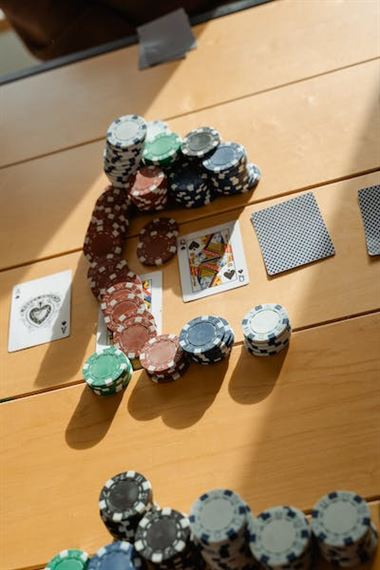Poker is a popular card game that has been played for centuries. It involves a combination of skill, strategy, and luck. As with any game, there are specific terms and phrases that are commonly used in the world of poker. Whether you are a beginner or an experienced player, it is essential to understand these terms to improve your gameplay and communicate effectively with other players. In this article, we have compiled a glossary of common poker terminology to help you navigate the game with ease.
All-In and Other Common Poker Betting Terms
Poker is a game of skill, strategy, and luck. It’s a game that has been played for centuries and has evolved into many different variations. Whether you’re a seasoned player or a beginner, understanding the terminology used in poker is essential. In this article, we’ll cover some of the most common poker betting terms, including the all-in bet.
All-In Bet
The all-in bet is a term used in poker when a player bets all of their remaining chips. This bet is typically made when a player believes they have a strong hand and wants to put all of their chips on the line. When a player goes all-in, they are essentially risking everything they have left in the game.
If another player wants to call an all-in bet, they must have enough chips to cover the entire bet. If they don’t, they can only call with the chips they have left. If a player goes all-in and no one calls, they win the pot without having to show their cards.
Blind Bet
The blind bet is a mandatory bet that is made by the two players to the left of the dealer. The player to the immediate left of the dealer makes the small blind bet, while the player to their left makes the big blind bet. The purpose of the blind bet is to create a pot for players to compete for.
The small blind bet is typically half the size of the big blind bet. For example, if the big blind bet is $10, the small blind bet would be $5. The blind bets rotate around the table with each new hand.
Call
A call is a bet that matches the previous bet made by another player. For example, if a player bets $10, and another player wants to call, they must also bet $10. Calling is a way for players to stay in the game without raising the bet.
Check
A check is a bet of zero dollars. When a player checks, they are essentially passing the action to the next player without betting any money. Checking is only possible if no other player has made a bet in the current round.
Fold
A fold is when a player decides to forfeit their hand and exit the game. When a player folds, they lose any chips they have already bet in the current round. Folding is a way for players to cut their losses and avoid losing more chips.
Raise
A raise is a bet that is higher than the previous bet made by another player. For example, if a player bets $10, and another player wants to raise, they must bet more than $10. Raising is a way for players to increase the size of the pot and put pressure on their opponents.
Understanding the terminology used in poker is essential for any player who wants to be successful. The all-in bet, blind bet, call, check, fold, and raise are some of the most common poker betting terms. By familiarizing yourself with these terms, you’ll be able to communicate effectively with other players and make informed decisions during the game. Remember, poker is a game of skill, strategy, and luck, and knowing the terminology is just one piece of the puzzle.
Understanding the Different Types of Poker Hands
The first type of poker hand is the high card. This is the lowest-ranking hand in poker, and it consists of five cards that do not form any of the other types of hands. The highest card in the hand determines its rank. For example, if you have a hand with an Ace, a King, a Queen, a Jack, and a 9, your hand would be ranked based on the Ace.
The second type of poker hand is the pair. This hand consists of two cards of the same rank, and three other cards that do not match. For example, if you have a pair of Aces and three other cards that do not match, your hand would be ranked based on the Aces.
The third type of poker hand is two pairs. This hand consists of two cards of one rank, two cards of another rank, and one other card that does not match. For example, if you have two pairs of Aces and Kings, and one other card that does not match, your hand would be ranked based on the highest pair.
The fourth type of poker hand is three of a kind. This hand consists of three cards of the same rank, and two other cards that do not match. For example, if you have three Aces and two other cards that do not match, your hand would be ranked based on the Aces.
The fifth type of poker hand is a straight. This hand consists of five cards in sequential order, regardless of their suit. For example, if you have a hand with a 5, 6, 7, 8, and 9, your hand would be ranked based on the highest card in the straight.
The sixth type of poker hand is a flush. This hand consists of five cards of the same suit, regardless of their rank. For example, if you have a hand with five hearts, your hand would be ranked based on the highest card in the flush.
The seventh type of poker hand is a full house. This hand consists of three cards of one rank, and two cards of another rank. For example, if you have three Aces and two Kings, your hand would be ranked based on the Aces.
The eighth type of poker hand is four of a kind. This hand consists of four cards of the same rank, and one other card that does not match. For example, if you have four Aces and one other card that does not match, your hand would be ranked based on the Aces.
The ninth type of poker hand is a straight flush. This hand consists of five cards in sequential order, all of the same suit. For example, if you have a hand with a 5, 6, 7, 8, and 9, all of hearts, your hand would be ranked based on the highest card in the straight flush.
The final type of poker hand is a royal flush. This hand consists of the five highest cards in sequential order, all of the same suit. For example, if you have a hand with a 10, Jack, Queen, King, and Ace, all of spades, you have a royal flush, which is the highest-ranking hand in poker.
In conclusion, understanding the different types of poker hands is essential to becoming a successful poker player. By familiarizing yourself with the common poker terminology related to the different types of hands, you will be better equipped to make informed decisions at the poker table. Remember, poker is a game of skill, strategy, and luck, and knowing the different types of hands is just one piece of the puzzle.
The Importance of Position in Poker: Early, Middle, and Late
In poker, there are three main positions: early, middle, and late. The early position is the first few seats to the left of the dealer. The middle position is the seats in the middle of the table, and the late position is the seats to the right of the dealer.
The early position is the most difficult position to play in poker. This is because you are the first to act, and you have the least amount of information about the other players’ hands. When you are in the early position, you need to be very selective about the hands you play. You should only play strong hands, such as high pairs or high suited connectors. You should also be prepared to fold if you do not have a strong hand.
The middle position is a little easier to play than the early position. You have more information about the other players’ hands, but you still need to be careful. You should only play strong hands, but you can also play some weaker hands if you think you have a good chance of winning. You should also be prepared to fold if you do not have a strong hand.
The late position is the easiest position to play in poker. This is because you have the most information about the other players’ hands. You can see how they have played their hands, and you can use this information to your advantage. When you are in the late position, you can play a wider range of hands than you would in the early or middle position. You can also bluff more often, because you have more information about the other players’ hands.
In addition to the three main positions, there are also other factors that can affect your position in poker. For example, if you are the first to act after the flop, you are said to be in the “under the gun” position. This is a difficult position to play, because you have even less information about the other players’ hands than you would in the early position.
Another factor that can affect your position in poker is the size of the blinds. The blinds are the forced bets that the two players to the left of the dealer have to make. If the blinds are small, then the early position is not as difficult to play, because you do not have to risk as much money to see the flop. However, if the blinds are large, then the early position is much more difficult to play, because you have to risk a lot of money to see the flop.
In conclusion, understanding the different positions in poker is essential to becoming a successful player. The early position is the most difficult position to play, and you should only play strong hands. The middle position is a little easier to play, but you still need to be careful. The late position is the easiest position to play, and you can play a wider range of hands. There are also other factors that can affect your position in poker, such as the size of the blinds. By understanding these factors, you can make better decisions and increase your chances of winning at poker.
Bluffing and Other Psychological Strategies in Poker
Poker is a game of skill, strategy, and psychology. While mastering the rules and basic strategies is essential, understanding the psychological aspects of the game can give you a significant advantage over your opponents. One of the most important psychological strategies in poker is bluffing.
Bluffing is the act of making your opponents believe that you have a stronger hand than you actually do. It is a powerful tool that can help you win pots even when you have a weak hand. However, bluffing is also risky, as your opponents may call your bluff and force you to show your cards.
To bluff successfully, you need to be able to read your opponents and understand their tendencies. You also need to be able to control your emotions and maintain a poker face. This means keeping a straight face, avoiding nervous tics, and not giving away any clues about the strength of your hand.
Another psychological strategy in poker is slow playing. Slow playing is the act of playing a strong hand weakly in order to lure your opponents into betting more. This can be a highly effective strategy, as it can make your opponents believe that they have a chance to win the pot, even when they don’t.
However, slow playing can also be risky, as it gives your opponents a chance to catch up and beat you. To use this strategy effectively, you need to be able to read your opponents and understand their tendencies. You also need to be able to control your emotions and not give away any clues about the strength of your hand.
A related strategy is the check-raise. The check-raise is the act of checking your hand with the intention of raising your opponents’ bet when they bet. This can be a highly effective strategy, as it can make your opponents believe that you have a weak hand, and encourage them to bet more.
However, the check-raise can also be risky, as it gives your opponents a chance to catch up and beat you. To use this strategy effectively, you need to be able to read your opponents and understand their tendencies. You also need to be able to control your emotions and not give away any clues about the strength of your hand.
Another psychological strategy in poker is the value bet. The value bet is the act of betting with a strong hand in order to extract more money from your opponents. This can be a highly effective strategy, as it can make your opponents believe that you have a weak hand, and encourage them to bet more.
However, the value bet can also be risky, as it gives your opponents a chance to catch up and beat you. To use this strategy effectively, you need to be able to read your opponents and understand their tendencies. You also need to be able to control your emotions and not give away any clues about the strength of your hand.
In conclusion, bluffing and other psychological strategies are essential tools in the game of poker. To use them effectively, you need to be able to read your opponents and understand their tendencies. You also need to be able to control your emotions and maintain a poker face. With practice and experience, you can become a master of these strategies and take your game to the next level.
Understanding common poker terminology is essential for any player who wants to improve their game. From the basic terms like “bluff” and “fold” to more advanced concepts like “pot odds” and “position,” having a solid grasp of these terms can help players make better decisions at the table. This glossary provides a comprehensive list of the most common poker terms, making it a valuable resource for both beginners and experienced players alike.





